Cain
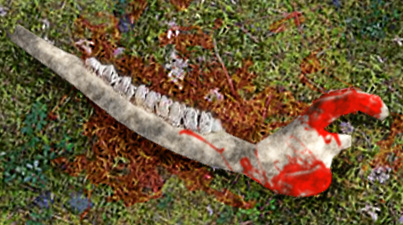
The Sacrifice. The Mark. The Cult.
A Sacrifice Gone Wrong
Genesis 4:1-8 KJV
1 And Adam knew Eve his wife; and she conceived, and bare Cain, and said, I have gotten a man from the Lord.
2 And she again bare his brother Abel. And Abel was a keeper of sheep, but Cain was a tiller of the ground.
3 And in the process of time it came to pass, that Cain brought of the fruit of the ground an offering unto the Lord.
4 And Abel, he also brought of the firstlings of his flock and of the fat thereof. And the Lord had respect unto Abel and to his offering:
5 But unto Cain and his offering he had not respect. And Cain was very wroth, and his countenance fell.
6 And the Lord said unto Cain, Why art thou wroth? and why is thy countenance fallen?
7 If thou doest well, shall thou not be accepted? and if thou doest not well, sin lieth at the door: and unto thee shall be his desire, and thou shalt rule over him.
8 And Cain talked with Abel his brother: and it came to pass, when they were in the field, that Cain rose up against Abel his brother, and slew him.
This last line 8 says nothing about why Cain slew Abel. Before I go any further I must say that this is all very Neolithic (even though these events precede it) which was at the time of the start of agriculture and animal domestication. The inference from the Biblical account is that sacrifice was part of the culture of that time. This account also reflects how these differing offerings would have been viewed during the Neolithic. Animals were more prized than agricultural products. Abel repeatedly taunted Cain over this preference. It was a sticking point.
The Urantia Book has this explanation as to what happened. First and foremost is that Cain was not Adam's son which is the real reason for the default. Adam by the way committed the same sin so that he would not be separated from Eve. Metaphorically speaking they did both partake of the apple. So as far as Adam and Eve's "sinning" the Urantia Book, the Bible and Qur'an are all in agreement. In the Islamic tradition it is stated that "had it not been for Eve, woman would have never acted unfaithfully toward her husband." (Hadith 3471, Volume 8) I'm not sure what that exactly refers to but I find it a surprising reference to infidelity if that is what is intended. Cain was a tiller of the soil and Abel was a herder. They did offer up their sacrifice according to custom. What the Bible does not say is about the relationship between Cain and Abel. Abel never did let Cain forget that Adam was not his father. Not good. Abel did not yet have those social skills that his heritage would have granted had he lived longer. But the Bible is correct in that the pivotal reason did revolve around this sacrificial thing. Of course unbeknownst to the Biblical authors was the lineage of Cain and the sibling rivalry of the two brothers. Both the Bible and the Urantia Book have Adam and Eve as having to leave the earthly Garden of Eden. In the Biblical story Satan as the serpent convinces Eve to eat of the fruit of knowledge. In Islamic tradition Satan (but not as a serpent) convinces Eve to name the first child to be born sound as Abd al-Harith and thereby naming her son after him, Satan. On this point the Urantia Books says Eve was deceived by the machinations of the "Devil" who really was Caligastia. And this brings us back to Cain the first born. The sad fact is that Cain did kill his brother in a fit of rage. I note here that in today's court of law Cain would not have been tried for murder in the first degree but for voluntary manslaughter with the argument being the mitigating factor of provocation. This is also known as Second Degree Murder and can carry a sentence as light as one year in prison plus a fine. Other states have a minimum of fifteen years to life. The Urantia Book does say a tribal mark was put (I say tattooed) on Cain which did afford him protection and I suspect awe. And thus did Cain depart for the land east of Eden known as the Land of Nod. He did marry and worked very hard to bridge the gap between the Adamites and the Nodites. Cain was in a peculiar position. He was of both races and to a small degree shunned ever so slightly by both and yet he was an ambassador between the two groups. He was successful at promoting peace between them. Cain did have a son and he was named Enoch. It is perhaps of his Nodite blood that contributed to his anger as the Urantia Book does say he had a bellicose nature for which Nodites were well known.
Where did the concept of the jaw
bone as weapon come from?
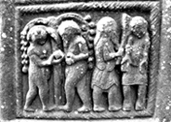
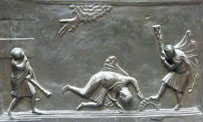
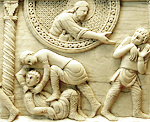
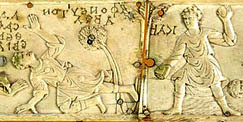
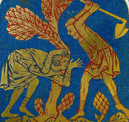
As for the jaw bone being the murder weapon it does not come from the Bible. The earliest scene I have found for this tale would be 900-923 Celtic, Muiredach's Cross showing Cain with a club. (http://www.sacred-destinations.com/ireland/monasterboice-photos/slides/400d_107p) Earlier art from Germany, the bronze doors from St. Michael's Church, Hildesheim, 1033 shows Cain with a club. From the cathedral of Salerno, from Italy is an ivory dated 1084 that shows Cain choking Abel. (http://www.lessing-photo.com/dispimg.asp?i=40010436+&cr=8&cl=1) The first record I found that is Angelo-Saxon is eleventh century. (http://www.jstor.org/pss/3046829 Meyer Schapiro) Another ivory plaque from Italy 11th-12th century shows Cain with a rock. (© Marie-Lan Nguyen / Wikimedia Commons) Another implement of destruction is the spade, Verdun Altar 1181 Austria (http://www.lessing-photo.com/dispimg.asp?i=15010513+&cr=46&cl=1) which also appears in the Bible historiale, French 1335 (http://larsdatter.com/shovels.htm). From the Cope of Darca is Cain with the jaw bone 13th century, English. There is a painting from the Ghent Altarpiece of Cain killing Abel with a jaw bone by Jan van Eyck, Flemish 1432. (http://www.britannica.com/EBchecked/topic/199258/Jan-van-Eyck) In 1511 German Albrecht Durer's woodcut depicts Cain with an ax. (http://counterlightsrantsandblather1.blogspot.com/2011_04_01_archive.html)
So it appears the jaw bone as the weapon has its roots in the traditions of the early Medieval English.
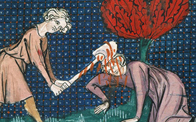
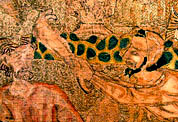
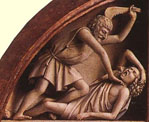
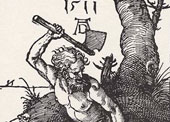
I would like to add this reminder to those familiar with this story from the Urantia Book and for those coming in "cold" to this web site. Cain was Adamic and Nodite, two groups who did not have much to do with each other. And the animosity between them is the reason Cain's father was slain before Cain was born. So the wound was still fresh at the time of the second garden. The Nodites, named after Nod, were of the fallen. They are the Nephilim from the Bible and the Igigi from the Sumerian tales. Up to this time Van was the titular head of the government which he relinquished to Adam and Eve upon their arrival. Thus the close association of Enki, Inanna and the Tree of Life. Now very powerful and authoritative rulers were established who among their many obligations were to reinstate the divine plan and create a large population of Adamites to genetically uplift early man. Yes, they were doing it the old fashioned way. This plan went astray because of the default. Adam and Eve were in a tremendously difficult situation. Because of the rebellion there were many problems. It almost seemed hopeless. Eve in her own way did try to better things but this was not sanctioned nor a part of the original plan. As they say - the road to Hell is paved with good intentions. And since they lost their immortality status the time frame for increasing their progeny was greatly shortened. But the Garden did continue down in time to the Sumerian flood just before the beginning of cuneiform writing. Calagastia did not have his way either. He tried to enlist Adam and Eve to support the rebellion but was without question dismissed. He did contribute to their fall but never was able to make them allies. The ramifications are tragic beyond measure. Eve's misstep has led to a bias against women. God considers men and women as equals and loves them both unconditionally. God loves all his children. But on this planet things are different. And there is Cain stuck in the middle of all this with a lot of bad press.
The story of Adam and Eve can also be found in the Persian legend in the Bundish. They were seduced by Ahriman in serpent form and committed the carnal sin. Here is an example of the default connected with sex. So there had to have been some stories of what would have been considered sexual behavior or conduct in regards to Eden. And there are.
The following is a short passage from the Sumerian and Babylonian epics discussed on the Assyrian Voice/bibleorigins web sites concerning Adam and Eve and the Garden of Eden. The full text is much longer but well worth the read if you are interested. Be aware that bibleorigins attempts to discredit much of the Biblical origins as reformatted myths and does not have a high regard for Christianity. But because of the scholarship on Sumerian history the site does produce helpful information and commentary on the ancient texts.
"Could Gilgamesh and Enkidu's attaining access to the trees of the forbidden Cedar Mountain have been reformatted in Genesis as Adam and Eve and the Trees of Knowledge and of Life? In the Inanna and Utu myth she descends to the earth to eat of cedar trees (eating the cedar nuts, or pine nuts), said act of "eating of a tree" giving her _knowledge_ about sexual matters. In Eden, Adam and Eve have knowledge of their nakedness _after_ eating of a tree and "later" engage in sex and have children. Thus the "wisdom" Adam and Eve attained was not only that they were naked, but of "how" to have sex, like Inanna. Some Jewish traditions (Hasmonean) understood the Tree of Life to a Date-Palm, of interest, is that one of the below seals of the Neo-Assyrian period shows the two adventurers slaying Humbaba (Huwawa) before a sacred Palm-Tree instead of a Cedar Tree. Palm Trees accompanied Cherubim in the Temple of Solomon, cf. 1 Kings 7:36. If I am correct in dating the Primary History, Genesis-Kings to 560 B.C., perhaps the Neo-Assyrian imagery is being drawn from as winged sphinxes are shown guarding a Sacred Date Palm?"
(http://www.assyrianvoice.net/forum/index.php?topic=26225.0 Walter Reinhold Warttig Mattfeld y de la Torre, M.A. Ed.)
(Quoted from: cf. pp. 78-79, 81. Robert Graves and Rapahel Patai. Hebrew Myths: The Book of Genesis. New York. Doubleday & Company. 1963, 1964)
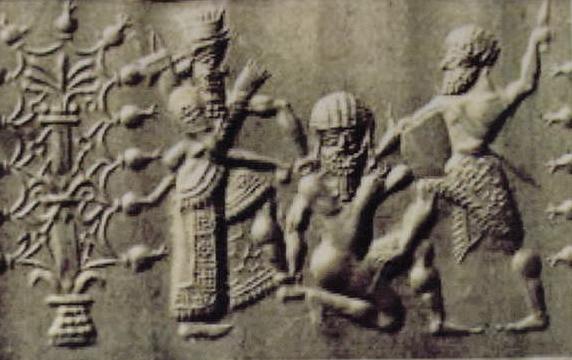
The slaying of Humbaba next to the Tree of Life
(http://www.bibleorigins.net/illustrationofgilgameshandenkidu.html)
Note: In the epic of Gilgamesh there is no mention of the Tree of Life per se. This cylinder relief does show the Tree in a typical stylized rendering. Therefore the above author's question is most likely true that the epic of Gilgamesh does contain within it allusions to the Garden of Eden. This story is both Sumerian and Babylonian and they are very broadly similar including the "solitary tree" reference but are decidedly different in other aspects. Understandable as the Babylonians consolidated the Gilgamesh tale from multiple Sumerian sources and therefore references to the Tree of Life may have be woven into the Gilgamesh tale. One other connection could be the serpent stealing the plant of immortality from Gilgamesh.
(See http://www.daimonas.com/pages/gilg-append.html for more info)
See link at bottom of page for another link to the complete Gilgamesh epic and you can read it for yourself.
Then click on the Back Button to return to this page after reading the epic of Gilgamesh.
Through these very old texts runs a sexual theme associating the eating of fruit with knowledge about sexual matters, nudity, some type of becoming fallen and in some cases becoming civilized.
"The late Sumerologist Professor Samuel Noah Kramer (1897-1990) suggested that perhaps some of Genesis' motifs and concepts are traceable to Mesopotamia via Abraham who lived at Ur before migrating to Haran and eventually Canaan. I suspect that Kramer is correct and that it probably was Abraham who transformed the Mesopotamian myths regarding the origins of primeval naked man who wandered the edin with wild animals and who gave them and life in the edin up to seek companionship with a naked woman he had encountered in the edin (That is to say Adam and Eve and their leaving of Eden are recasts of motifs associated with Enkidu and Shamhat and their leaving the edin as found in the Epic of Gilgamesh). Israel's forefathers who lived beyond the Euphrates are described in the Bible as being originally Polytheists. Apparently Abraham was a Polytheist too and therefore well-acquainted with Mesopotamian gods and goddeses and the stories about man's primeval origins. Perhaps it was Abraham who, upon repudiating Polytheism, recast the Mesopotamian motifs and concepts?"
(http://www.assyrianvoice.net/forum/index.php?topic=26225.0 Walter Reinhold Warttig Mattfeld y de la Torre, M.A. Ed.)
Samuel Kramer is my favorite Sumerologist and his insight concerning Abraham is something I have thought of myself except that instead of the stories originating from Ur these stories would have been from Melchizedek the Priest King of Salem. There are two reasons why I think this may very well have happened. First is the time frame. If Melchizedek was the origin for the Biblical account, whether that being with Abraham or not, the length of time it would have taken to repeat the story from generation to generation and then written down would have been relatively short. Second, the Eden story in the Bible is way closer than any of the ancient stories when compared to the Urantia Book. Melchizedek, I think, is a good bet. He was a celestial. Consider this: Hebrews 7:3 "Without father, without mother, without descent, having neither beginning of days, nor end of life; but made like unto the Son of God; abideth a priest continually." KJV So, whatever he said you could take to the bank. And he knew everything about the default.
When Adam and Eve left the Garden they left as mortals of the realm and no longer able to benefit from the Tree of Life. As the Bible tells it they did become agriculturists and herders. It seems unfair that Adam and Eve although they did make a tragic mistake and thus had lost their divinity status, had to abandon their home and leave a good portion of their family behind while Lucifer was left to pursue his plans of rebellion virtually unhindered which had a much greater impact on the planet. Where is the justice in that? But, there is a silver lining in all of this. Actually two. First, Adam and Eve in becoming human became indwelt by the divine Adjuster for the first time. In their original role as a Material Son and Daughter they did not have Thought Adjusters. But now so endowed as humans the universe with all its varied careers is opened to them and like all surviving mortals (us) will make the journey to Paradise at the center of creation, God's home. Cain also became Adjuster indwelt after sincere repentance and seeking divine assistance. The second is, because of the Lucifer rebellion we live on a spiritually isolated planet. We do not have direct angelic contact; no knowledge of universe affairs. The Urantia Book has a designation for this. Survivors from such planets are called "agondonters, meaning evolutionary will creatures who can believe without seeing, persevere when isolated, and triumph over insuperable difficulties even when alone." (Urantia Book p579). So what that means to you is that when resurrected you will already have that street cred that everyone else will be so envious of. Yes.
Added 21 June 2014
The above copy is not quite correct in regards to the "punishment" of Adam and Eve. The first thing is that Adam and Eve were not evicted from the garden. They chose to leave and that was because of the Nodites living to the north were on the war path for revenge. Cain's father was a Nodite and was slain by inhabitants of the garden because of what had happened. And this was the start of the "long and bitter warfare between the Adamites and the Nodites". Adam did not want any confrontation and elected to leave in a quest for a new home. It was while on this trek to what would become the second garden between the Tigris and the Euphrates that they learned of their fate. Their judgement was delivered by Gabriel. Having violated the covenant of their trusteeship they had degraded themselves to the status of the mortals of the realm. This is a very important point. It is based on the immortality status of their material order of sonship. They were of a dual nature on this planet. Their physical bodies needed nourishment and their dependence on the superenergy stored in the fruit of the tree of life was maintained through an intellectual association with the circuit of the Spirit. So in effect their trangression was an intellectual default not a moral one. They had shot themselves in the foot. There was no higher authority convicting them. Gabriel only restated the consequences of their decisions. Even though they had been warned of what would happen if they defaulted and they understood its ramifications, it still happened.
Thanks and appreciation goes to the Perth Urantia Book Study Group of Australia for their contribution and clarification on the default of Adam and Eve (http://www.perthubsg.com).
The
Mark of Cain, the Axis Mundi, the Garden of Eden and the Knights Templar
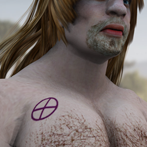 "In
symbolic form, the Rosi-crucis [symbol for the holy grail] was the
original and longest standing mark of sovereignty – and this
is where the secondary Rosy Cross definition comes into play, for this
insignia was indeed a red cross within a ring. The early Bible writers
condemned this royal device as being the Mark of Cain."
"In
symbolic form, the Rosi-crucis [symbol for the holy grail] was the
original and longest standing mark of sovereignty – and this
is where the secondary Rosy Cross definition comes into play, for this
insignia was indeed a red cross within a ring. The early Bible writers
condemned this royal device as being the Mark of Cain."
(http://www.geocities.com/CapitolHill/Parliament/3460/lords1.html)
It is unfortunate that there were no foot notes to these statements. I think the writer of the above is mislead and leaves some interesting questions unanswered like how did they know this symbol was the Mark of Cain? This web site is no longer available for follow up. I checked. But as luck would have it I did locate the source for this quote which is from David Williams and the full text can be found here: http://www.scribd.com/doc/8123904/British-Israel. Besides other subjects, this text refers to the Grail King theory along with the Anunnaki bloodline, the Lord of the Rings, the Scottish Rite, George Washington and I stopped at the KKK. Read at your own risk.





I found
a page on the Knights Templar
that had a similar premise. Unfortunately it also has a
mishmash of concepts, some of which are about Jesus and are quite far
off the mark. That
being so the information on the Mark of Cain does have some seemingly
historical data such as "...
the Knights Templar received from Pope Eugenius in 1146 the 'Mark of
Cain' as a symbol for their knight order". Also, "The Mark of Cain is
symbolized by a Red Cross surrounded by a Circle." (http://en.chartressecrets.org/templars/red_cross.htm)
This
page does not correctly trace it back to its pre-Mesopotamian roots.
Rather than linking the Garden of Eden to the
symbol, which
to me seems as a no-brainer, they link it to the "third eye" and
thereby taking a hard turn away from its true source.  "In
symbolic form, the Rosi-crucis [symbol for the holy grail] was the
original and longest standing mark of sovereignty – and this
is where the secondary Rosy Cross definition comes into play, for this
insignia was indeed a red cross within a ring. The early Bible writers
condemned this royal device as being the Mark of Cain."
"In
symbolic form, the Rosi-crucis [symbol for the holy grail] was the
original and longest standing mark of sovereignty – and this
is where the secondary Rosy Cross definition comes into play, for this
insignia was indeed a red cross within a ring. The early Bible writers
condemned this royal device as being the Mark of Cain."(http://www.geocities.com/CapitolHill/Parliament/3460/lords1.html)
It is unfortunate that there were no foot notes to these statements. I think the writer of the above is mislead and leaves some interesting questions unanswered like how did they know this symbol was the Mark of Cain? This web site is no longer available for follow up. I checked. But as luck would have it I did locate the source for this quote which is from David Williams and the full text can be found here: http://www.scribd.com/doc/8123904/British-Israel. Besides other subjects, this text refers to the Grail King theory along with the Anunnaki bloodline, the Lord of the Rings, the Scottish Rite, George Washington and I stopped at the KKK. Read at your own risk.





Another Templar site states: "1146 Knights Templar given the ancient Sumerian "Mark of Cain", a red cross in a circle, as their symbol, by Pope Eugenius III, a Cistercian Pope." (http://www.thetruejesus.org/templar/chronology.htm) Even though it is specific on who and when, it is just another myth. The red cross of which there are more than several interpretations is their most used symbol which does not include a circle. The main problem with this story of the Pope is why would he give such a symbol to the Templars when the early Bible authors were condemning it? There is one positive spin on this mark. Since it is a mark of protection some Biblical scholars have presented it as a sign of God's compassion and mercy. This is true but the popular view is that it is a mark of condemnation.
"The Knights Templars adopted the splayed red cross as a symbol, initiated by Pope Eugenius III. It is the same cross used as those of the Assassins or Hashishim". (http://www.mindserpent.com/American_History/introduction/intro_012.html) This is why all Templar references to the Mark of Cain are a red cross. Those who label the real symbol as the Mark of Cain are mistaken and have not done their homework. The first cross to the left above is known as the splayed cross and sometimes called the eight pointed cross. This is the cross the Pope gave to the Templars. This cross is also known as the Maltese cross but really is confused with it. The actual Maltese cross is the cross of the Hospitallers of St. John who were known as the "Knights of Malta". Those colors are silver on black and it does resemble the splayed cross to its left. (http://www.medwaycropcircle.co.uk/Article10.htm) The third cross to the right is the Croix Pattée another eight pointed cross. (http://en.chartressecrets.org/templars/red_cross.htm) This cross has a number of styles but it is always red without the circle. Sometimes it is found on a background of a round disc, hence the ring or circle. But it does point to something important: that the Mark of Cain was known to contain a cross. It seems strange that a case of mistaken identity would help contribute to a larger understanding of this forgotten image for only the legend remains. If you were to research images of the Knight Templars you will see a red cross but not within a circle. In fact even though the Chartres Secrets web page says the symbol was a cross in a circle, this middle cross is the one on that page. No circle. The forth cross is the Iron Cross. It too gets confused with the other crosses. And the last cross is the Rosy/Rose Cross which is the symbol of the Rosicrucians from which it is alleged that this organization is from the Knights Templar. The rose always accompanys this cross. It too has differing styles.

This is
an example of what I mean about the careless use of
the cross symbol. The image above is a
screen shot from a web site declaring this red cross is the Templars cross. It is the Iron Cross.
No wonder there is confusion as to what it actually looked like.
screen shot from a web site declaring this red cross is the Templars cross. It is the Iron Cross.
No wonder there is confusion as to what it actually looked like.
"The Rosicrucian rose is another form of the Rose or Rosy Cross, a Christian symbol originating in the first century. It was adopted as a Hermetic occult symbol during the English Renaissance and was re-popularized by the Nineteenth century magical order the Golden Dawn.
The equal-armed cross symbolizes resurrection and rebirth, the earth axis [emphasis added], and the world of matter; the rose, the unfolding nature of spiritual growth, the blood of Christ, awakening. The two emblems combined show the triumph of the spiritual over the material. The history of the Rose Cross is an unusual one. It has been linked with the equilateral red cross of the Knights Templar. The appearance of the rose cross in “Christian” art and poetry is often taken as a secret communication of heresy - the worship of the Goddess Venus, or even secret tantric sex practices, particularly in connection with the medieval troubadours". (http://symboldictionary.net/library/graphics/symbols/rrose)
If you have read the page on the Tree of Life then you will have my background explanation for this symbol. It occurred to me while thinking about this mark, as it relates to the Sumerian and Babylonian concept, to ask why is the axis mundi called the world tree and the Tree of Life which did not make any sense to me. There is a lot of opinion of what the axis mundi is but not why it relates to the Tree of Life. I have as yet to read anything that specifically answers this question. It is so basic and fundamental as to be a slap on the forehead. The Babylonian concept of the axis mundi is the center of the universe, the axis which the world revolves, the center of power, authority and kingship. This is all very well established. At one time Eden was that and more. Adam and Eve were the rulers above all. Eden was the axis mundi of the planet and was represented by the world tree, the Tree of Life. The axis mundi and the Tree of Life both represent divinity and kingship.
The Sumerians wrote about someone else who was directly connected to the Tree. That would be Enki. But he more than anything was associated with the Tree of Life's alter ego - the Tree of Knowledge. Both Inanna and Enki are of the Anunnaki. They are closely related in the Sumerian epics. The one where Enki gives the mes to Inanna, the power to grant kingship for example, is where Inanna is Enki's daughter. This being so, did the ancients know where they came from? The Sumerians were clear on this: they came from heaven and therefore the axis mundi in all cultures was the cosmic corridor that connected the planet with heaven. The axis mundi was as religious as it was political. In Mesopotamia kingship was granted by Inanna, a goddess. It also points to the longevity and power of this symbol that was carried unbroken by the shamans to the priesthood. At its source it is a religious symbol (which is why the early church fathers could possibly have known about it and its history) but also of kingship as expressed through Inanna.
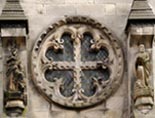 The image to the left is
a "rose" window in the Rossly
Chapel, Scotland. You can click on it for a larger view. Look closely
and you will see the cross in a circle with the
flure-de-lys, the very Sumerian symbol of the Tree of Life. Inside this chapel you
will find also the football shaped pine cone which represents the fruit
of immortality. "The chapel
is famous both for its decorative art and its mysterious associations
with the Knights Templar, the Holy Grail, and the Freemasons".
(http://www.sacred-destinations.com) All the necessary
elements are here: the cross, the Tree of Life which is the
axis mundi and the
circle, the encircling ocean which defines the world's boundary. These
then fulfill the requirements of the
Sumerians, Babylonians and Assyrians to satisfy that
this symbol
is the Edenic Mark of Cain. I rest my case.
The image to the left is
a "rose" window in the Rossly
Chapel, Scotland. You can click on it for a larger view. Look closely
and you will see the cross in a circle with the
flure-de-lys, the very Sumerian symbol of the Tree of Life. Inside this chapel you
will find also the football shaped pine cone which represents the fruit
of immortality. "The chapel
is famous both for its decorative art and its mysterious associations
with the Knights Templar, the Holy Grail, and the Freemasons".
(http://www.sacred-destinations.com) All the necessary
elements are here: the cross, the Tree of Life which is the
axis mundi and the
circle, the encircling ocean which defines the world's boundary. These
then fulfill the requirements of the
Sumerians, Babylonians and Assyrians to satisfy that
this symbol
is the Edenic Mark of Cain. I rest my case.The
World Tree as the Axis
Mundi
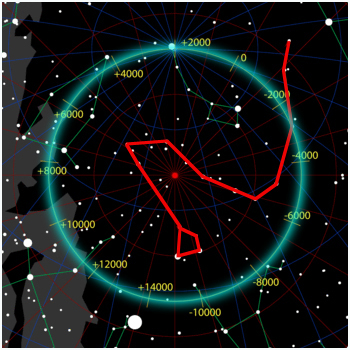
The pole star would be
the
most accurate definition for the attachment of the axis mundi and is
the accepted description for this
subject. But I think that this is not the case. The axis
mundi
is attached to no star, in fact it is attached to nothing because there
is an empty space at the center of the precessional rotation. This by
itself really holds no water until you look at a star map of the
northern polar region (to the left). There is a constellation located
there called
Draco, the dragon - the serpent (in red). This constellation literally
wraps
itself around this empty point (red dot). I think the serpent that
wraps
itself around the Tree of Life is a symbol for this constellation.
And this makes sense. The Tree of Life is wrapped by a serpent and the axis
mundi
is also wrapped by a serpent. Since Draco wraps itself around the
center of precession it will forever twist about this pole never to
leave it. They are in fact bound together for eternity. Does this sound
like I am reaching too far? Well, apparently the Egyptians did not think
so. The Egyptians referred to this constellation as a hippopotamus and
known as the "Mother Goddess". Tree of Life, Mother Goddess, sound
familiar? Read the next paragraph and see if you can spot the
references to Inanna.
"The Hippopotamus was widely known in ancient days, again and like all other gods and goddess, it had two sides to its nature, the protective, and the destructive. Many things about ancient Egyptian mythology and beliefs (probably one and the same thing back then) are still being debated. Some subjects are just left alone, or only studied by the very few. But one debate is (among some) that are the goddess the same just with different names and portrayed differently? Or are there more than one goddess? In this post we will take a very short look at two of these ancient hippopotamus goddess.
Ipet (Apet/Opet); She was a very ancient primal goddess. Sometimes her name is found with Mutt's and Nut's name, connecting them and their natures. She is also believed to be the Star Draconis, which connects her to the afterlife - the soul's journey.
Reret; means 'sow' she was also known as Reret-weret, which means the Great Sow. She is in this form a representation of the constellation called 'Isis' and this constellation seems to be our day Draco. In ancient days around 2500 B.C the pole-star was known as Thuban, and this star lies inside Draco."
(http://www.mysteriesofancientegypt.com/2010/01/hippopotamus-goddesses.html)
"The Pharaoh Khufu ruled ancient Egypt around 2550 BC and was buried in the largest of the Giza pyramids when he died. During his time, Thuban was the pole star, (because of Earth's precession) around which all other stars revolved. Khufu's burial chamber was fashioned deep inside the Great Pyramid. Two skinny shafts bore outward from the chamber.
For decades, scholars thought they were airshafts. But in the 1960s, astronomers found that they have an astronomical purpose. It was found that one of the shafts pointed directly towards Thuban. The other was aimed at the belt of Orion, which symbolized Osirus."
"Because Thuban was the pole star 5000 years ago the ancient Egyptians keenly observed it. Some of Draco's stars were part of their constellation of Hippopotamus and some were of the Crocodile. They appear on the planisphere of Denderah and the walls of the Ramesseum at Thebes. The hieroglyph for the Hippopotamus was used for the heavens in general while the constellation is supposed to have been a symbol of Isis Rathor, Athor, or Athyr, the Egyptian Venus. Draco's stars were also said to represent the falcon headed god Horus."
(http://starryskies.com/The_sky/constellations/draco.html)
"Draco is also associated with the dragon that guarded the Golden Fleece and was killed by Jason, as well as with the dragon killed by the Phoenician prince Cadmus before he founded the city of Thebes in Boeotia in Greece. In early Christian mythology, Draco was identified with the serpent that tempted Eve in the Garden of Eden."
(http://www.topastronomer.com/StarCharts/Constellations/Draco.php)
Before the constellations were defined as we know them today the Greeks (Greek philosopher Thales) trimmed off Draco's wings, which wound around Ursa Major and perhaps Ursa Minor. Yes, the Mesopotamian Draco was a winged serpent, residing in that place in the sky that was the gateway to heaven, the cosmic portal for the axis mundi. Stars rule.
Click Here for more info on the Mark of Cain
The World Tree and Mayan
Cosmology
Although
the above quote is about the Mayans it echoes the Neolithic images of
Europe and elsewhere. Almost all Neolithic images are connected to the
sky with references to stars and constellations. Only recently have
these star maps become recognized for what they truly are. So
accordingly the Milky Way is the canopy of the great tree the World
Tree and the axis mundi
is its trunk. Also the axis
mundi was hinged, as most web sites claim, to the north or pole star thus a direct
connection between the sky and earth. Close enough.Sometimes
answers are found in the least expected places. The answer to why the axis
mundi is a tree
might be found in what the Mayans have written:
"I realized that every major image from Maya cosmic symbolism was probably a map of the sky. . . . [The] patterns in the Milky Way and the constellations were directly related to the Maya vision of Creation. (Linda Schele in Freidel, Schele and Parker, Maya Cosmos)
Linda Schele discovered that the World Tree is a literal depiction of the heavens as well as an abstract symbol. Her investigations, vividly recounted in Maya Cosmos, led her to the conclusion that the Milky Way is the World Tree. The Maya long count was initiated on or about August 13 in 3114 BC, the date of Creation. At dawn in mid-August, the Milky Way stands erect, running through the zenith from north to south. It becomes the axis of the heavens, the raised up sky."
(The http://mountzion144.ning.com/group/thegospeloftheredman/forum/topics/star-nation-teachings?
commentId=2127676%3AComment%3A460731&groupId=2127676%3AGroup%3A404615)
"I realized that every major image from Maya cosmic symbolism was probably a map of the sky. . . . [The] patterns in the Milky Way and the constellations were directly related to the Maya vision of Creation. (Linda Schele in Freidel, Schele and Parker, Maya Cosmos)
Linda Schele discovered that the World Tree is a literal depiction of the heavens as well as an abstract symbol. Her investigations, vividly recounted in Maya Cosmos, led her to the conclusion that the Milky Way is the World Tree. The Maya long count was initiated on or about August 13 in 3114 BC, the date of Creation. At dawn in mid-August, the Milky Way stands erect, running through the zenith from north to south. It becomes the axis of the heavens, the raised up sky."
(The http://mountzion144.ning.com/group/thegospeloftheredman/forum/topics/star-nation-teachings?
commentId=2127676%3AComment%3A460731&groupId=2127676%3AGroup%3A404615)
When we shed our 21st century preconceived ideas about early man will we be more attuned to what these ancient images actually mean. I can tell you from my experience in doing the research on this site that too often have I seen secular 21st century thinking imposed upon ancient images that are patently wrong. Remember that pretty much of this ideology is post industrial revolution thinking. That represents an extremely short span of time. Draw your own conclusions.
"The Hungarian world tree was also known for it’s golden apples, the snakes in it’s roots in the underworld, and eagles nested on it’s branches, all forming parallels with the Sumerian haluppu tree. World trees also feature in Chinese, Indian, Greek, Siberian, and Mesoamerican cultures."
(http://lost-history.com/gilgamesh.php)
Figurines
and the Mother Cult
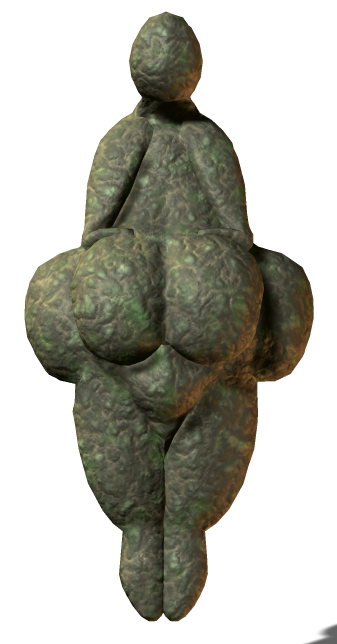 Cain
had left another legacy and that was of the mother cult.
It was Eve that he went to for spiritual help and guidance. It was
after Eve's ministry and his
repentance that
he received the Thought Adjuster and he did become aware of this divine
presence. In the Aegean and particularly on the island of Crete
descendants of Cain glorified Eve in the worship of the "great mother".
Jacquetta Hawks a well known archaeologist has played a major role in
the
understanding of this Minoan primordial goddess-worship. The Danubians
were Andonites (aboriginals) and were influenced by
missionaries from Crete - these same cult members. They became mother
worshipers as well and much of central Europe was settled by these
people. They got their name from the Danube River which they followed
into Europe as well as moving via the Balkan peninsula. It was the
custom of these mother worshipers to cremate their
dead in what we now call dolmens. And what about the palm sized Venus
figurines?
Yes, them too.
Cain
had left another legacy and that was of the mother cult.
It was Eve that he went to for spiritual help and guidance. It was
after Eve's ministry and his
repentance that
he received the Thought Adjuster and he did become aware of this divine
presence. In the Aegean and particularly on the island of Crete
descendants of Cain glorified Eve in the worship of the "great mother".
Jacquetta Hawks a well known archaeologist has played a major role in
the
understanding of this Minoan primordial goddess-worship. The Danubians
were Andonites (aboriginals) and were influenced by
missionaries from Crete - these same cult members. They became mother
worshipers as well and much of central Europe was settled by these
people. They got their name from the Danube River which they followed
into Europe as well as moving via the Balkan peninsula. It was the
custom of these mother worshipers to cremate their
dead in what we now call dolmens. And what about the palm sized Venus
figurines?
Yes, them too.Dumuzi
and Enkimdu
The Sumerian tale "Inanna
Prefers the Farmer" contains the Cain and Abel motif:
"Enkimdu is featured prominently in the myth "Inanna Prefers the Farmer," in which both he and the god Dumuzi are attempting to win the hand of the goddess Inanna. While Inanna is quite infatuated with the down-to-earth farmer, her brother Utu/Shamash attempts to convince her to marry Dumuzi instead. Both Dumuzi and Enkimdu face off in an argument over who will win Inanna. While Dumuzi is aggressive in his arguments, attempting to prove that he is far better, Enkimdu is more docile and peaceful, attempting to resolve the situation diplomatically.
The clay tablet on which the myth is written has unfortunately been damaged over the passage of time, but from later myths such as "Dumuzi and Inanna" and "Inanna's Descent into the Underworld," it is clear that Inanna eventually selects Dumuzi as her spouse and that he is murdered."
(http://en.wikipedia.org/wiki/Enkimdu)
"Enkimdu is featured prominently in the myth "Inanna Prefers the Farmer," in which both he and the god Dumuzi are attempting to win the hand of the goddess Inanna. While Inanna is quite infatuated with the down-to-earth farmer, her brother Utu/Shamash attempts to convince her to marry Dumuzi instead. Both Dumuzi and Enkimdu face off in an argument over who will win Inanna. While Dumuzi is aggressive in his arguments, attempting to prove that he is far better, Enkimdu is more docile and peaceful, attempting to resolve the situation diplomatically.
The clay tablet on which the myth is written has unfortunately been damaged over the passage of time, but from later myths such as "Dumuzi and Inanna" and "Inanna's Descent into the Underworld," it is clear that Inanna eventually selects Dumuzi as her spouse and that he is murdered."
(http://en.wikipedia.org/wiki/Enkimdu)
This is interesting as Cain as Enkimdu the farmer (Eve's son) is favored by Inanna and Able as Dumuzi the shepherd (Adam's son) is favored by Utu. Also note that it is Dumuzi that is the demanding one. In another epic it is Dumuzi who is murdered. In this epic of Dumuzi and Enkimdu it is Dumuzi who eventually wins Inanna's hand. This epic tracks well with what has been discussed on this page. The Eve/Cain-Adam/Abel relationship, the death of Dumuzi (but not connected with this tale) and Enkimdu losing out - perhaps an allegory for Cain's departure to the east. He could not possibly be with Inanna if he were in another country. This tale is the opposite of what we have been taught. Cain as Enkimdu "is more docile and peaceful" while Dumuzi is the quarrelsome one. This may be a reflection on Cain the ambassador from his later times and an insight into very ancient knowledge about what really had happened. It was after all Cain who became the peace maker between the Adamites and Nodites.
The
Solar Cross
This
symbol is also know as the solar cross, sun cross and sun wheel. It
also known as Odin's cross in Northern Europe which is interesting as
Odin is connected to the Tree of Life. The cross in a circle as the
solar cross is the most popular definition for this sign.
"A universal symbol from the most remote times; it is the cosmic symbol par excellence. It is a world center and therefore a point of communication between heaven and earth and a cosmic axis, thus sharing the symbolism of the cosmic tree, mountain, pillar, ladder etc (p. 45).
Buddhists believe that the cross represents both the tree of life and spiritual nourishment. To many adherents, it is the also a symbol of the universal man. To them, the vertical line represents the spiritual intellectual side of mankind, and the horizontal, the earthly passive, and female side. They also think of it as forming the four rivers of Paradise flowing from the root of the Tree of Life.
The Solar cross is probably the oldest religious symbol in the world, appearing in Asian, American, European, and Indian religious art from the dawn of history. Composed of an equal armed cross within a circle, it represents the solar calendar- the movements of the sun, marked by the solstices. Sometimes the equinoxes are marked as well, giving an eight armed wheel. The swastika is also a form of Solar cross (website, About Alternative Religion article, Symbols). "
(http://www.eternalcog.org/ecgbooklets/the_truth_cross.html - The Truth about The Cross © 2005 Copyright The Eternal Church of God)
By all accounts the origin of this cross symbol is very ancient. Some say it is Neolithic but most likely predates the Neolithic and is Paleolithic. I doubt we will ever really know its true origin and how it came to be but consensus is that it is religious.
"A universal symbol from the most remote times; it is the cosmic symbol par excellence. It is a world center and therefore a point of communication between heaven and earth and a cosmic axis, thus sharing the symbolism of the cosmic tree, mountain, pillar, ladder etc (p. 45).
Buddhists believe that the cross represents both the tree of life and spiritual nourishment. To many adherents, it is the also a symbol of the universal man. To them, the vertical line represents the spiritual intellectual side of mankind, and the horizontal, the earthly passive, and female side. They also think of it as forming the four rivers of Paradise flowing from the root of the Tree of Life.
The Solar cross is probably the oldest religious symbol in the world, appearing in Asian, American, European, and Indian religious art from the dawn of history. Composed of an equal armed cross within a circle, it represents the solar calendar- the movements of the sun, marked by the solstices. Sometimes the equinoxes are marked as well, giving an eight armed wheel. The swastika is also a form of Solar cross (website, About Alternative Religion article, Symbols). "
(http://www.eternalcog.org/ecgbooklets/the_truth_cross.html - The Truth about The Cross © 2005 Copyright The Eternal Church of God)
By all accounts the origin of this cross symbol is very ancient. Some say it is Neolithic but most likely predates the Neolithic and is Paleolithic. I doubt we will ever really know its true origin and how it came to be but consensus is that it is religious.
So we have the Urantia Book, the Bible (which includes the Torah) and the Qur'an all writing about the same elements of Adam and Eve, the Tree of Life, the Devil, a default, the slaying of Abel by Cain, sacrifice and the Garden of Eden all of which points accurately to actual events in antiquity. And we have all the necessary historical elements to conclude that the cross in a circle is the Mark of Cain. Bet you weren't ready for that.

 Back
to Intro
Back
to Intro  Gilgamesh
Gilgamesh  The
Garden of Eden
The
Garden of Eden 
